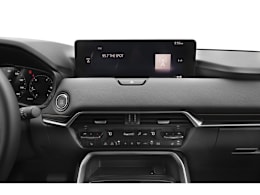The CX-70 is Mazda’s all-new for 2025, two-row midsized SUV. Interestingly, much of the CX-70 is borrowed from its larger three-row sibling, the CX-90. The two not only share a platform and the same powertrain; they even have the same exterior dimensions. Under the hood is the inline six-cylinder engine developed for the CX-90, paired with the same eight-speed automatic transmission. As is the case with the CX-90, a plug-in hybrid model is also offered for the CX-70. We rented a CX-70 from Mazda, and found that it was too similar to our previously-tested CX-90 to justify purchasing one. This road test is based on our impressions of the rented CX-70 combined with test results from the CX-90 (which will be noted as such).
If you’re considering buying a CX-70, know that you’re buying a two-row SUV that is really the size of a midsized three-row model. Using a rear-wheel-drive-based platform (but with standard all-wheel drive)—a configuration preferred by sports luxury makers such as BMW, Genesis, and Mercedes-Benz—was important for Mazda. Being able to place the engine longitudinally (parallel with the centerline of the car) rather than transverse (perpendicular to the centerline), as is often dictated by a front-wheel-drive design, meant that Mazda’s engineers could use an inline-six rather than a V6. The result is one of the finest-handling two-row SUVs that also happens to be endowed with one of the sweeter engines. Step inside the well-crafted cabin and it’s clear that this is Mazda’s boldest attempt yet to move the brand upscale.
We’d classify that attempt as “mostly successful.” We love how well the powertrain works out on the road, though some low-speed hiccups dampened our feelings around town. And while the big SUV handles its size and weight nicely through curves, the suspension feels borderline too firm at times. It also doesn’t help matters that some of the CX-70’s controls—in particular the gear selector—are quirky and unintuitive to use, and small-item storage is surprisingly skimpy compared to others in the class. If you’re looking for performance and fine handling, the CX-70 may be your ticket. But if comfy cruising and clever storage solutions are higher on your wish list, there are better options out there.
Most CX-70s come with a 280-horsepower, 3.3-liter turbocharged inline six-cylinder engine with a 48-volt mild-hybrid setup originally developed for the CX-90. Beyond some initial hesitation during rolling stops, the engine propelled our third-tier 3.3 Turbo Preferred Plus CX-90 test model down the road with authority. The numbers back that up: our CX-90 sprinted from 0 to 60 mph in 7.2 seconds. Out on the road, the engine delivers effortless power and a polished sound, and the driving experience is aided by a smooth-shifting eight-speed automatic transmission. Our tested CX-90 achieved 24 mpg overall. We would expect a similar result for the CX-70.
High-end 3.3 Turbo S models use the same basic engine as the 3.3 Turbo, but horsepower is bumped to 340, giving it the most oomph and torque of any production engine from Mazda. Keep in mind that the standard Turbo’s performance numbers are based on 87-octane fuel, while the Turbo S is based on the recommended 91 octane.
We also tested the plug-in hybrid version of the CX-90, which is also offered on the CX-70.
The CX-70’s driver-focused platform helps make it one of the best-handling three-row SUVs. It feels taut and agile through corners and the sharp steering provides genuine feedback to the driver about tire grip and road texture. The steering is on the slower side at low speeds, though, which you mostly notice when taking tight corners. Around our track, the big Mazda showed good grip and a commendable handling balance, albeit with considerable body roll when pushed to its limits. The ride skews on the firm side, which results in the occasional sharp impact punching through, even on versions that have the smaller 19-inch wheels and tires. We would advise against opting for a CX-70 with the 21-inch tires because they make the vehicle notably stiff and uncomfortable on even slightly rough roads.
The front seats are comfortable with just enough lateral support to hold you in place when taking corners with some tenacity. The driving position is nicely sorted, with lots of headroom, an excellent view of the gauges, and well-placed armrests. The wide center console tends to hem in the driver’s right knee, but we appreciate that it’s padded there. The cabin adheres to Mazda’s uncluttered elegance design work, with lots of padded surfaces, high-quality switchgear, and contrasting stitching. Top-end trims look even more impressive, thanks to an abundance of suede and higher-quality leather. Small-item storage up front is lacking compared to similar SUVs, with an oddly shallow bin underneath the center armrests. We measured the CX-70’s cargo space and it was approximately the same as the CX-90.
The most serious knock against the CX-70 may be the odd design of some of its controls. For starters, the infotainment display screen isn’t touch-enabled like in most vehicles, except when using Android Auto or Apple CarPlay on higher trims. And interacting with the center controller knob and on-screen menus is complicated due to the multiple layers to wade through. The electronic gear selector is also frustrating, thanks to its illogical upside-down L-shaped shift pattern.
All CX-70s come standard with automatic emergency braking with pedestrian and bicyclist detection, automatic emergency braking that operates at highway speeds, blind spot warning, rear cross traffic warning, lane departure warning, lane keeping assistance, adaptive cruise control, and automatic high beams.























